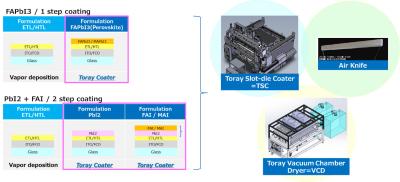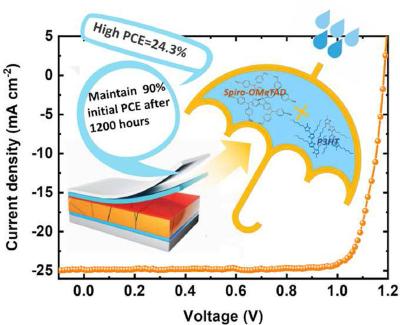Perovskite-Info weekly newsletter
Published: Tue, 05/09/23
The Perovskite-Info newsletter (May 9, 2023)
Cannot read this? View it online here
Researchers design stable and efficient 4T silicon-perovskite PV cell with transparent contact
Researchers at the Indian Institute of Technology Bombay have reported NIR-transparent perovskite solar cells (PSCs) with the stable triple cation perovskite as the photo-absorber and subsequent integration with a Si solar cell in a 4T tandem device. The scientists said that the cell provides outstanding stability in the dark, as well as continuous heating conditions.
The top perovskite cell incorporates a room-temperature sputtered transparent conducting electrode (TCE) as a rear electrode. It has an n–i–p structure and utilizes an anti-reflecting coating, an electron transport layer (ETL) made of tin(IV) oxide (SnO2), a perovskite layer, a molybdenum oxide (MoOx) layer, and a spiro-OMeTAD hole transport layer (HTL). The MoOx buffer layer protects the perovskite photo-absorber and charge transport layers from any sputter damage.
Researchers design stable and efficient inorganic wide-bandgap perovskite subcells
Researchers at Nanjing University, Nankai University, East China Normal University and University of Toronto have developed new inorganic wide-bandgap perovskite subcells that could increase the efficiency and stability of all-perovskite tandem solar cells. Their design involves the insertion of a passivating dipole layer at the interface between organic transport layers and inorganic perovskites within the cells.
The scientists explained that efficient tandem solar cells made using hybrid organic inorganic wide-bandgap perovskites have thus far maintained only 90% of their initial PCE for 600 hours of operation at their maximum power point (MPP). Therefore, achieving long-term stability has become a critical issue for the commercialization of all-perovskite tandem solar cells.
Large-scaled Perovskite Slot-die coating technology by Toray Engineering
The following is a sponsored post by Toray Engineering
In an article dated Oct 17, 2022, Toray Engineering introduced its slot-die coating technology, as well as other technologies that can be utilized for perovskite layer deposition for large-scaled production.
This article will describe two processes to formulate Perovskite layers using such technologies, using Toray Engineering’s manufacturing equipment. One of the processes is a 1-step coating method that applies FAPBI3 coating to formulate a power-generation layer. The other process is a 2-step coating method that double coats PBI2 and FAI to formulate a power-generation layer. For both processes, by combining its technologies in slot-die, vacuum dryer, and air knife, Perovskite layers can be formulated on large-scale glass surfaces.
Researchers develop binary mixed hole transport layer for better perovskite solar cells
Researchers from China's Chongqing University, the Chinese Academy of Sciences (CAS) and JA Solar Holdings Co., along with South Korea's Ulsan National Institute of Science and Technology (UNIST) and Germany's CTF Solar and have designed a perovskite solar cell based on a binary mixed hole transport layer (HTL) that reportedly offers better performance than HTLs that rely on commonly utilized hygroscopic dopants.
The team mixed two popular hole transport materials to form a binary mixed HTL, that exhibited improved moisture resistance. As a result, PSCs equipped with the mixed HTL achieved a champion power conversion efficiency (PCE) of up to 24.3% and superior operational stability. The cells without encapsulation can maintain 90% initial efficiency after storage in dark ambient conditions (30% RH) for 1200 hours. These results suggest that such a mixed HTL could be a promising strategy to meet the future photovoltaic applications demands with low-cost as well as excellent efficiency and device stability.
Researchers develop additive for perovskite solar cells with enhanced efficiency and stability
A research team from City University of Hong Kong (CityU) and University of Washington recently developed a multifunctional and non-volatile additive which can improve the efficiency and stability of perovskite solar cells (PSCs) by modulating perovskite film growth.
The team explained that the additive can be used to modulate the kinetics of perovskite film growth through a hydrogen-bond-bridged intermediate phase. The additive enables the formation of large perovskite grains and coherent grain growth from bottom to the surface of the film. The enhanced film morphology reportedly results in significantly reduced non-radiative recombinations, thus boosting the power conversion efficiency of inverted (p–i–n) solar cells to 24.8% (24.5% certified) with a low energy loss of 0.36 eV. The unencapsulated devices exhibited improved thermal stability with a T98 lifetime beyond 1,000 h under continuous heating at 65 ± 5 °C in a nitrogen-filled glovebox. This effective approach can also be applied to wide-bandgap perovskites and large-area devices to show reduced voltage loss and high efficiency.
Metalgrass LTD
9 Har Tsin St.
Kfar Sava Hasharon 4430809
ISRAEL
Unsubscribe | Change Subscriber Options









